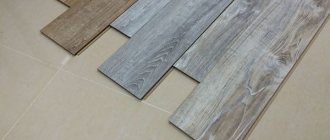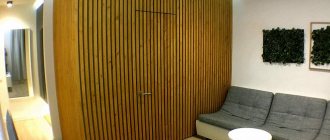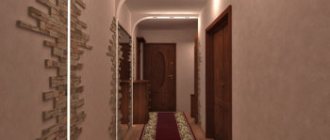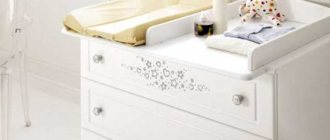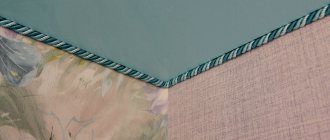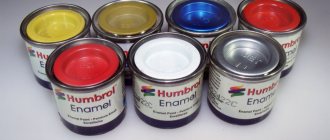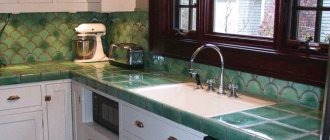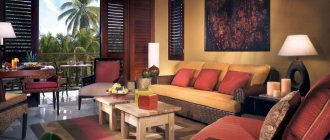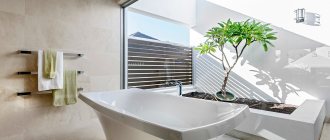Durable, hygienic and durable, laminate consistently ranks among other flooring products. A variety of shades and textures allows you to choose an option for absolutely any interior. Choosing texture and color is not a big problem. It is much more difficult to decide on the class of laminate. The most widely used flooring is class 32 and 33. How do these coatings differ from each other? Does it make sense to buy a higher laminate or can you save money?
How is flooring made?
To better understand the concept of “class” of laminate, it is necessary to consider the structural features of this material. It is made from several layers:
- lower;
- average;
- decorative;
- top, called overlay.
The main layer is the middle layer, which is responsible for sound and heat insulation. It has the greatest thickness and is made from fiberboard or particle board. If it is a high-quality material, special plastic is added to the composition. The bottom one acts as a buffer between the middle layer and the base of the floor; it is made from paper that is treated with a special resin. There are varieties on sale in which it is made of polystyrene, cork or aluminum foil. Decorative is the layer on which the design is applied. It is usually made of paper and is thin. The texture directly affects what kind of wood the coating imitates. The buyer himself selects the option he likes. Overlay is a protective film. It is most often made from acrylic resin, which is antistatic. This layer protects the floor from contamination, mechanical stress, and fading.
31st class
This class of laminate is intended for apartments, and for rooms with low traffic or for small families (no more than 2-3 people). Obviously, a material of this quality costs less than others, so it is not surprising that manufacturers are ready to guarantee it only a few years of operation.
Class 31 laminate has the following characteristics:
- laminated board thickness – 6-8 mm;
- the surface is smooth, with a slight gloss, without relief;
- on such boards the simulated wood texture usually looks blurry;
- before laying such a laminate, it is necessary to use an additional substrate;
- It's perfect for an office or bedroom .
But it cannot be used in the bathroom or kitchen, since it is usually not impregnated with moisture-resistant compounds.
In the hallway and living room it will also have to be used with caution: do not drop heavy objects on it, do not mix heavy furniture on it, etc.
If you follow all the specified precautions, then even such a laminate can last 10-12 years.
From different manufacturers, class 31 laminate costs $45-65, that is, slightly less than class 32 material, so it is often chosen for flooring in public spaces.
How is the laminate class determined?
The floor covering marking consists of two numbers. They denote a class that is determined by testing. Laminate flooring goes on sale with full labeling. This allows you to accurately select the required class. Testing can be done in different ways. The most stringent includes 18 indicators. It is conducted by the European Association, which gives the manufacturer the right to produce flooring. The laminate company uses a test that checks 7 points:
- abrasion resistance;
- resistance to moisture;
- resistance to indentation of relatively heavy objects;
- resistance to fire and smoldering;
- behavior of the floor covering to the movement of furniture;
- resistance to various types of pollutants;
- resistance of the laminate to movement on the surface of furniture on wheels.
The better the readings, the higher the class of the laminate. This does not mean that the buyer needs to chase the highest performance. As the class increases, the cost of coverage also increases. In many premises, average indicators are sufficient, and, therefore, there is no need to pay more.
Which class of laminate is better to choose?
If you decide to cover the floor with laminate in your apartment, many questions immediately arise related to the choice of which class of laminate is better. Laminate is a special coating made from pressed wood impregnated with special substances and a protective film.
Laminate is divided into classes and types according to the degree of wear resistance of the coating. What class of laminate is better to choose for an apartment? What is the best wear resistance class for laminate? It is important to know what exactly is suitable for solving your problem, so as not to buy an inappropriate or overly expensive option.
Let's look at each class in more detail.
When choosing a laminate you need to know its class
Structure and classification of laminate
Which class of laminate is better to choose?
On a note! Operation classes are divided according to the degree of load on the floor covering and the degree of traffic in the room in which it is decided to install the laminate.
Impact resistance and wear resistance are fundamental factors. Sound insulation, light tolerance, water resistance, and other loads are also important.
Laminate classes vary in strength, wear resistance and other parameters
The classification of laminate varies; many countries have their own method and type of classification.
Manufacturers must indicate the class of the laminate
In Russia, the European laminate classification is used. It involves passing the coating through almost 20 tests, according to the results of which the laminate is assigned a certain marking.
There are 7 types, each assigned its own number - from 21 to 23 and from 31 to 34. They belong to different tens, that is, the first numbers - 2 and 3 - indicate the rooms in which they are supposed to be used. 2 – these are residential premises, laminate flooring for apartments, for home use. 3 – commercial area of laminate application. The second numbers (1, 2, 3 and 4) indicate the degree of wear resistance of the laminate; a higher number means greater strength and wear resistance. No one can answer which class of laminate is better. It all depends on the specific case.
Laminate consists of several layers that have a specific function.
Laminate flooring consists of several layers. The very first and lowest layer is the technical layer. its task is to impart elasticity to the floor and impart the ability to insulate moisture. It is often made from specialized paper impregnated with polymer compounds.
The second layer is the main one and is made from high-density fiberboard panels. In fact, this layer is a laminate, and its thickness is more than 90% of the total thickness of all layers. He is assigned to perform all fixing and strength functions. The moisture resistance of the coating, strength, and resistance to stress depend on it.
The main layer is followed by a decorative layer. It practically does not affect the properties of the laminate; it is a common imitation of any image. Often this is an imitation of a wooden covering, but it can also be marble or the illusion of a stone floor.
The polymer layer protects the laminate from water
The last layer is the protection of the laminate - a transparent polymer layer. The degree of wear resistance of the coating, which in the classification is the second digit of each class, depends on its thickness.
It is worth noting that the strength of a laminate coating and its wear resistance are not the same thing. Strength depends on the boards included in the main coating layer. Whereas wear resistance depends on the thickness of the protective top layer.
Wear resistance of laminate is important in high traffic areas
There are several main parameters of a good laminate. First of all, this is, of course, wear resistance - the main parameter that everyone focuses on when purchasing and installing a coating.
Water resistance and excellent stain resistance are also important: a good laminate should be treated with special water-repellent and antiseptic solutions.
Its strength is resistance to indentation, this is especially important for rooms in which heavy furniture is installed, creating constant pressure on the floor covering. Resistance to damage from furniture movement, laminate resistance to dirt.
21, 22, 23 laminate classes
Class 23 should be used on stairs, in the hallway or kitchen
What is the best class of laminate for an apartment? These are just the laminates of these three classes. They have increased resistance to water and humid environments, which can be important for apartment conditions.
Therefore, it is clear which laminate class 23 is best to choose for the hallway, corridor and kitchen. These are the rooms where traffic is highest, and class 23 is the most resistant of the three, suitable for home use. And it will be ideal in these rooms.
You can use cheaper laminate in the bedroom
Good resistance to moisture also fits perfectly here - in the hallway, near the front door, you often have to deal with water from the street, for example, in the form of snow; There is high humidity in the kitchen due to cooking. The abrasion coefficient of this floor is about 2500 units.
In other rooms (bedrooms, offices, living rooms) the traffic is not so high, and for these rooms a laminate of class 21 or class 22 is suitable. These two classes last quite a long time, more than 5 years, and at the same time are the most inexpensive, budget option. The abrasion of these classes is equal to 900 and 1800 units, respectively.
31, 32, 33 laminate classes
The following three classes of laminate coating 31, 32, 33 are considered coatings intended for commercial enterprises and office premises.
It is necessary to install more wear-resistant laminate in the office
Which class of laminate is better among these types also depends on the level of wear and use of the room. Class number 31 (the wear level here is also 2500, like class 23) can be used in offices, office areas, meeting rooms, and conference rooms. In such premises, traffic is much higher than in ordinary apartments, therefore, by installing a commercial class laminate in your home, which differs in cost from class number 21 slightly, you can increase the service life of your laminate by 2 times - from 5-6 years to a whole decade and longer.
For office premises with high traffic and, therefore, faster wear and tear or gyms, which laminate is better - 33 class and 32 class. In the part of the store salons where visitors walk, it is better to install them in hairdressing salons. Class 32 is the most popular class on the laminate flooring market. Its market share is 60% due to its ideal price-quality ratio for office businesses. Class 33 is used on dance floors and in restaurants.
It is good to use class 34 laminate on the dance floor
Which laminate class is better - 32 or 33? The wear resistance level of these classes is 4000 and 6500, respectively. Therefore, depending on the purpose, finances that can be spent on flooring, trafficability, you need to determine for yourself which one is better suited. But by installing a more expensive option (in this case, class number 33), you increase its service life. Especially when installing it in a room with low levels of wear and tear. The service life, depending on cross-country ability, can vary from 5 to 10 years. This coating is also suitable for a country house.
Important! In any case, the coating should be treated with care.
Existing laminate categories
The flooring was originally sold in six grades. The first three categories began with the number "2". They are found on sale, but almost everywhere they have already been discontinued. It was produced exclusively for residential premises, but its resistance to abrasion and moisture left much to be desired. And if the buyer wants to purchase a laminate of class 21, 22 or 23, it is recommended to use it only in rooms where there is little foot traffic. In addition, you need to be prepared for the fact that after a few months it will lose its attractiveness. This is due to the fact that the resistance of the coating to various external factors is low. The popularity of “two” class laminate was due to its low cost, but flooring has become less in demand given the durability of the “three” category. The overpayment in this case turned out to be completely justified. The durability balanced out the higher price.
Methods for laying laminate
There are several types of installation of laminate flooring:
- Straight, also known as classic – installation is done from windows or doors.
- Diagonal - laying is done from the corner.
- Non-threshold - only an experienced specialist can perform it due to its high complexity.
- “Herringbone” - thanks to this type of installation, an interesting pattern is created, but only a master of his craft can install it.
The first type is more popular, since it requires less material consumption and is easier to install.
But on open surfaces or when installing laminate with a complex pattern, a diagonal view is sometimes used. Here you will need a larger supply of material, depending on the complexity of joining the decorative part.
It is impossible to do the third and fourth types yourself at home and require the help of a professional. But these types of installations really decorate the interior, although they are difficult to install. The professional craftsmen of the Parquetti store will be able to help you in laying any floor coverings, visiting Tyumen and the region.
Third class laminate
Originally produced for use in public buildings. It was manufactured in such a way as to withstand heavy loads, but quickly became widespread in residential premises. There are four classes in the “third” category:
- 31;
- 32;
- 33;
- 34.
The first number in the marking indicates for which premises the laminate is intended, and the second - moisture resistance, thickness, resistance to mechanical stress, and so on. The class is determined by the lowest value. If all indicators correspond to category 33, and one - 32, then the laminate is labeled class 32.
Laminate structure
Laminate flooring is made in the form of boards of various lengths and widths. It is enough to lay them on a leveling screed or a chipboard base and fasten them using the locks at the ends of the lamellas. And immediately after installation is completed, it will be possible to walk on such a finish without additional work (scraping, painting, varnishing).
Structurally, laminate of all classes consists of three main layers:
- Below is basic (stabilizing).
- In the middle is the carrier.
- The top is decorative with a protective coating.
Each of these layers performs its own function. Together they are pressed together into a laminate lamella under high pressure and high temperature. Moreover, each manufacturer uses its own technology for gluing these materials into a single pie - albeit with minimal differences.
Laminate layers
Bottom stabilizing layer
The base layer of the laminate is made of paper impregnated with synthetic resins. Its main task is to protect the laminated board from below from moisture. It also contains information about the brand, batch and wear resistance class of the product.
How long the supporting base will remain in its original form without deformation depends on the quality of manufacture of the stabilizing layer. Water is the most serious threat to laminate flooring. If it reaches the wood board in the middle of the lamella through the moisture-resistant coating below, then this fiberboard will instantly swell.
And it doesn’t matter how high the class of the laminate is stated in the labeling. Moisture and wood are incompatible. As a result, the swollen section of the floor will have to be replaced.
Some manufacturers glue a soundproofing substrate to the base layer at the factory. But most often the laminate and this sublayer, usually made of foamed polyethylene, come separately.
Load-bearing, middle layer
The supporting layer is made of high-density (HDF, 750–1200 kg/m3) or medium-density (MDF, 400–750 kg/m3) fiberboards. The laminate of the former is heavier and more durable. The second option will cost less, but will not last as long.
Wood support base:
On the side, this layer has tongue-and-groove locks for connecting individual lamellas into a single floor covering. The thicker and denser it is, the more reliable these latches are. But at the same time, the thickness of the laminate, as well as its cost, increases.
Types of laminate locks
Decorative layer
The topmost layer is made of melamine resin with high wear resistance and strength. Immediately below it is kraft paper with a pattern applied, which can imitate the structure of various trees, stones, etc. There are a wide variety of colors and patterns on sale.
The class of the laminate, usually designated by numbers from “31” to “34,” depends on the thickness of the melamine. The thicker it is and the more resistant to various mechanical influences, the more durable and more expensive the laminate coating. Moreover, any of the options can be mounted on either a wet or semi-dry floor screed or other base. The main thing is that they are well dried before laying the finish.
Decorative laminate layer
Advantages of flooring and dependence on class
Laminate of absolutely any category has the following positive properties:
- long service life;
- wear resistance;
- environmental Safety;
- high thermal and sound insulation;
- ease of care;
- ease of installation.
These advantages have made flooring a sought-after material. The higher the class, the less the laminate is susceptible to negative external influences.
Newly added classes
Laminate manufacturers are not standing still, creating new types of coatings that can be classified as classes 41-43. They have not yet been included in ISO or GOST standards. The material most often found on sale is category 43.
This laminate is made on the basis of polyvinyl chloride. Thanks to this, the laminated coating acquires improved technical characteristics: resistance to moisture, durability, hardness. In the production process of PVC-based material, certified components are used to ensure that the coating will meet environmental safety standards. Laying class 43 laminate flooring in children's rooms, kindergartens and hospitals is allowed, since the mentioned laminated coating does not emit harmful substances during operation.
The following advantages of PVC-based laminate can be highlighted:
- maintainability;
- panel flexibility;
- high degree of wear resistance;
- Possibility of installation on a “warm floor” system;
- saving the drawing during use;
- adaptation of the material to uneven floors;
- resistance to temperature changes;
- moisture resistance;
- resistance to damage by microorganisms;
- easy care;
- environmental and hygienic safety.
A small disadvantage of the material can be considered its high price.
How long will laminate flooring last?
The durability of the floor covering directly depends on the thickness of the material. The larger it is, the longer the laminate will last. Considering that the last number in the marking means thickness, class 34 is considered the most durable, and class 31 is considered the thinnest. Laminate of the “third” category is certainly superior to the “two”, but preference should be given to the option that ideally matches the price and quality. This criterion is best met by grades 32 and 33. They are affordable and will last 10-15 years.
The main manufacturers of laminate 32 strength classes
Depending on the manufacturer, the price of the coating will vary. Laminate is in demand in the building materials market, so all global companies are engaged in its production. But it’s worth taking a closer look at the highest quality and proven European brands:
- Tarkett;
- · Classen;
- Aberhof
- Egger;
- Haro;
- · Kaindl;
- Balterio;
- · Quick-Step;
- · Witex, etc.
Germany has conquered the laminated coating market and occupies a leading position in production quality.
Belgium follows. Its models are also popular and gaining momentum; one of the most famous Belgian floor coverings is Quick-Step laminate.
Of course, the price of European manufacturers will be an order of magnitude higher than others, but they will also last much longer: without damage or unpleasant surprises.
Which class should you prefer - class 32 or class 33?
To choose a floor covering of a specific category, you need to study the features of each. Class 32 laminate was originally intended for use in public spaces with low traffic. If on average it is visited by 200-300 people, the flooring will last approximately 10 years.
It will fully retain its attractive appearance and other positive properties. Typically, repairs are carried out once every ten years, so the coating does not have time to wear out. The thickness of the upper protective layer - overlay - ranges from 0.2 to 0.4 mm. Class 33 laminate is more resistant to negative environmental influences. This coating is suitable for premises visited daily by up to 500 people. It does not fade when exposed to bright sunlight and will last at least 15 years. The floor covering, which belongs to class 33, acquired its improved properties due to the fact that it is made using an additional layer.
Conclusions and recommendations
For installation in residential premises, laminate of 33-34 classes seems optimal. Such a floor covering will cope well with mechanical loads and can be cleaned with a damp cloth using household chemicals. Other advantages of these materials include the fact that they retain the pattern and may have a relief texture that prevents slipping.
When choosing a laminate, pay attention to its decorative characteristics. It is desirable that the color of the flooring be combined with the overall style of the interior design of the room. Laminate with good technical characteristics is more expensive, but the service life of such material is longer. It is characterized by maintainability, so investing in the purchase of commercial-grade flooring is completely justified and advisable.
If you are wondering what laminate grades 35, 36, 37, 38 mean, read this article.
How are these classes similar?
Laminates of both classes 32 and 33 have common features:
- they are produced using similar technologies;
- both floor coverings have reliable bottom and top layers;
- laminates of each class include a fairly thick middle layer in their structure;
- are presented in a variety of designs and are distinguished by the beauty of their texture.
Often on sale there are coatings that are made “like a log” or “like a parquet.” Lower quality laminate does not have this texture. The thickness of the middle layer for both classes varies from 7 to 11 millimeters, but coverage of category 32 may be inferior to category 33 in some of the parameters, which is determined during testing.
Types of textures, colors and shades of laminate
The pattern on the decorative layer can be different; now there are several types on the market:
- the most common is imitation wood. For realism, manufacturers even create grooves and irregularities, like real wood. There are all kinds of colors on the market from dark to light: wenge, laminate oak, walnut, ash, chestnut, pine and others;
- natural stones - for lovers of natural stone surfaces, such as marble, granite, anthracite, laminate manufacturers have also produced coatings of various colors and imitations to suit every taste;
- other colors and designs. In addition to the classics, on the shelves of hardware stores you can see any color options from plain black laminated coatings to various original designs for the most daring experimenters.
In addition to various colors and textures, the coating can be glossy laminate or matte, and the structure can be smooth or embossed. But no matter what kind of renovation, interior style and color scheme the person in the room has in mind, manufacturers have already prepared a suitable option for any occasion.
Where and what kind of laminate to lay?
If flooring is purchased for an apartment, there are expert recommendations that will allow you to decide on a specific class, which depends on which room the laminate will be installed in:
- For the kitchen, it is recommended to choose a coating marked 33, since the load on the floor here is quite high.
- Class 32 laminate is suitable for the bedroom, living room and children's room, since there are rarely a large number of people here. In the living room they usually watch TV or relax, rather than pace around the room.
- A coating with a class of at least 33 should be installed in the hallway. This room is actively used, so a laminate of a lower category will quickly become unusable.
If you follow the recommendations of specialists, there will be no problems with choosing a floor covering.
Comparative characteristics of class 32 laminate
In order not to make a mistake with your choice, you should learn more about the differences between 8 mm and 12 mm thick laminate, and, depending on your goals, decide to purchase one of the types.
- The laminated coating with a thickness of 12 mm is more stable.
- In 12 mm models, the protective layer has an anti-slip effect, is moisture resistant, and does not fade from sunlight.
- 8 mm coating has worse sound insulation.
- 12 mm laminate is durable and not susceptible to damage from sharp heels, rearranging heavy furniture, or the claws of pets.
- The thicker the laminate flooring, the easier it is to install and remove if you have to move.
The best laminate manufacturers - which company to choose
Products from European manufacturers have proven themselves best on the Russian market; laminate from Russian-German joint ventures is popular.
We invite you to familiarize yourself with the list of the best companies:
- Pergo;
- Berry Alloc;
- Kaindl;
- Tarkett;
- Kronostar.
In the link you can learn more about the rating of the best laminate manufacturers. For those wishing to find out what parameters the product class depends on, we suggest delving into the material.
Laminate selection options
Having decided on the class of laminate for each room of an apartment or house, you need to take into account other parameters of the material that affect the duration of its operation.
Thickness
The thickness of the board affects the performance of the floor:
1. Resistance to loads (important to consider when arranging rooms with heavy furniture and appliances);
2. Strength (the thicker the board, the stronger it is);
3. Thermal insulation and sound insulation qualities (if the room has a “warm floor” system, the boards should not be too thick. In this case, it is preferable to purchase a thin, high-quality laminate.
Moisture resistance
Having decided to lay laminate flooring in rooms with high humidity, you need to purchase special material. The raw materials for its base are solid wood fibers, not shavings. The workpieces, pressed under significant pressure and at high temperatures, are treated with resin and wax, which prevent moisture from penetrating inside.
For rooms with high humidity, manufacturers offer two types of water-repellent laminate:
1. Moisture resistant – withstands contact with liquid for some time;
2. Waterproof - not afraid of direct, prolonged contact with water, since its base is made of plastic.
34th class
It’s not enough to say that class 34 laminate is waterproof; it is also the most durable of all types used for sports and commercial applications . The most advanced technologies are used to produce this flooring. Some brave manufacturers even give a lifetime guarantee for class 34 waterproof laminate in the kitchen.
Class 34 laminate flooring is based on high-density fiberboard (HDF). A layer of kraft paper with moisture-resistant impregnation is glued onto it. The top layer is also formed by several layers of melamine resin with various additives, which is responsible for the durability and wear resistance of the laminated coating.
The thickness of this class of laminate remains at the same level as that of materials of the 33rd class - 10-12 mm.
The bottom layer of the material is occupied by a soundproofing substrate, which not only prevents sounds from below from entering the room, but also prevents the appearance of squeaks during the operation of the laminate.
Characteristics of class 34 coating
Considering the characteristics of laminate by class, it is worth paying attention to one more: 34. This type of material appeared later than others. It is intended for installation in rooms with maximum permissible load and high humidity.
It finds application in commercial structures where there are powerful equipment in the premises that creates vibrations and the like. In apartments, this material can withstand maximum loads. The service life of such coating is up to 50 years. This is the most expensive laminated coating and is therefore rarely used in residential apartments.
This is a very durable environmentally friendly material. The accompanying documents indicate its moisture resistance, remarkable wear resistance, and ability to withstand high temperatures. The slats have good noise insulation properties.
Whether it is worth laying such material in the apartment is the owner’s decision. Suitable for finishing the floor in the hallway, kitchen and other areas of the apartment. The coating will withstand high traffic levels: such as in cinemas, clubs, shopping and entertainment centers. Many models are equipped with a soundproofing underlay, i.e. when laying the underlay does not need to be laid.
Advantages
:
- very durable panel base;
- durable non-abrasion surface;
- Excellent scratch resistance, impact resistance;
- moisture resistance of the board and locking elements;
- environmental friendliness;
- antibacterial property;
- resistance to temperature fluctuations;
- anti-slip property;
- The guarantee is given up to 50 years or for life.
Manufacturers:
- Pergo - Sweden;
- Ritter - Russia + Germany;
- Maestro Club - Norway.
Read about the selection of laminate and manufacturers: How to choose laminate for an apartment
